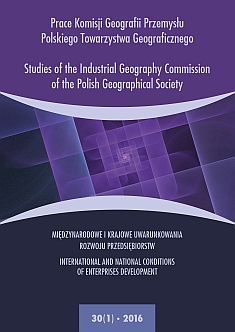Territorial Range of Internationalization of Polish Enterprises: Questionnaire Results
DOI:
https://doi.org/10.24917/20801653.301.2Keywords:
distance, internationalization, psychic distance, territorial scopeAbstract
For several decades in dynamically growing internationalization literature there have been many research trends. The territorial scope of internationalization is one of the oldest research problems in the area of the internationalization process of the enterprise. It was originally analyzed as concentration vs. diversification (Ayal, Ziph, 1978). Currently, the scope of internationalization is one of the components of most measures of the extent of internationalization (Kuivalainen, Sundqvist, Saarenko, 2012). In general, small and medium-sized enterprises in the early stages of the process of internationalization carry out expansion in the close/neighboring markets where the so-called psychic distance is small (Johanson, Vahlne, 1977). Conversely, transnational, multinational and global firms frequently operate in global markets (Vahlne, Ivarssonn, 2014; Wach, 2014). In addition, the scope of internationalization is also affected by other factors, e.g. industry in which the firm operates, innovation and technological sophistication (high-tech / low-tech) (Daszkiewicz, 2015). The main empirical objective of the article is to identify the key determinants of the territorial scope of internationalization of the surveyed enterprises, and the impact of these factors on the scope of their international activities. The article presents partial results of research carried out on a sample of 355 internationalized enterprises. Firms were interviewed by questionnaire using CATI interviews (Computer Assisted Telephone Interviewing). The questionnaire was carried out in 2015 under a grant OPUS carried out at the Department of Economics and International Relations, University of Economics in Kraków. CalculationsweremadeusingStatistica® PL v. 10.
Downloads
Metrics
References
Ayal, I., Zif, J. (1978). Competitive Market Choice Strategies in Multinational Marketing. Columbia Journal of World Business, 13(3).
Bell, J. (1995). The Internationalization of Small Computer Software Firms: A Further Challenge to “Stage” Theories. European Journal of Marketing, 29(8), 60–75.
Cannon, T., Willis, M. (1981). The Smaller Firm in International Trade. European Small Business Journal, 1(3).
Ciszewska-Minaric, M., Wąsowska, A. (2012). Znaczenie dystansu w procesie internacjonalizacji przedsiębiorstw. Management and Business Administration. Central Europe, 6(119), 3–22.
Daszkiewicz, N. (2014). Firm-Level Internationalisation from the Theoretical Perspective: Knowledgebased Approach. W: N. Daszkiewicz, K. Wach (red.). Firm-Level Internationalisation and Its Businass Environment. Gdańsk: Gddańsk University of Technology Publishing House, 9–18.
Daszkiewicz, N. (2015). Internationalisation of Born Globals from The Theoretical Perspective. Problemy Zarządzania, 13, 1(51), 70–81.
Duliniec, E. (2011). Koncepcje przedsiębiorstw wcześnie umiędzynarodowionych. Rozważania terminologiczne. Gospodarka Narodowa, 1–2, 63–80.
Ghemawat, P. (2001). Distance still matters: The hard reality of global expansion. Harvard Business Review, 79(8), 137–147.
Jarosiński, M. (2013). Procesy i modele internacjonalizacji polskich przedsiębiorstw. Warszawa: Oficyna Wydawnicza Szkoły Głównej Handlowej.
Johanson, J., Vahlne, J.E. (1977). The Uppsala Internationalization Process Model of Knowledge Development and Increasing Foreign Commitments. Journal of International Business Studies, 8(1), 23–32.
Johanson, J., Vahlne, J.E. (1990). The mechanism of internationalization. International Marketing Review, 7(4), 11–24.
Johanson, J., Wiedersheim-Paul, F. (1975). The Internationalization of the Firm: Four Swedish Cases. Journal of Management Studies, 12(3), 305–322.
Kuivalainen, O., Sundqvist, S., Saarenko, S. (2012). Internationalization Patterns of Small and Mediumsized Enterprises. International Marketing Review, 21(6), 645–665.
Madsen, T.K., Servais, P. (1997). The Internationalization of Born Globals: an Evolutionary Process? International Business Review, 6(6), 561–583.
Nordstrom, K., Vahlne, J.E. (1994). Is the globe shrinking? Psychic distance and the establishment of Swedish sales subsidiaries during the last 100 years. W: M. Landeck (red.). International trade: Regional and global issues. New York: St Martin’s Press, 41–56.
O’Grady, S., Lane, H.W. (1996). The psychic distance paradox. Journal of International Business Studies, 27(2), 309–333.
Ojala, A., Kontinen, T. (2010). Distance Factors in the Foreign Market Entry of Software SMEs. W: Software Business. Springer, 49–62.
Vahlne, J.E., Ivarsson, I. (2014). The globalization of Swedish MNEs: Empirical evidence and theoretical explanations. Journal of International Business Studies, 45(3), 227–247.
Wach, K. (2014). Theoretical Framework of the Firm-Level Internationalisation in Business Studies. W: A. Durendez, K. Wach (red.). Patterns of Business Internationalisation in Visegrad Countries – In Search for Regional Specifics. Cartagena: Universidad Politécnica de Cartagena, 13–32.
Downloads
Published
How to Cite
Issue
Section
License
Articles are published under the terms of the Creative Commons License (CC BY-ND 4.0; Attribution– NoDerivs).

